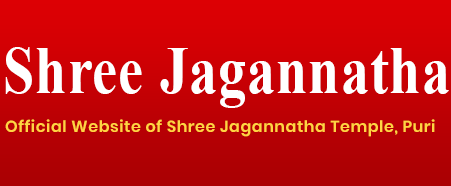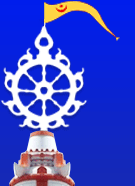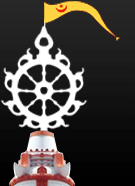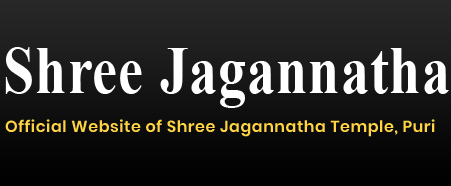LIVING TRADITION >> Sebakas
The persons entrusted with seva-puja (ritual services) of the deities are known as sevakas (servitors). Most of them enjoy hereditary rights to perform the ritual services in the temple. It is stated by some scholars that King Anangabhima Dev of the 13th century A.D. introduced 36 categories of sevakas known as chatisanijog. The number of sevakas (servitors), and the association of sevakas (known as nijogs) increased gradually and new ritual services were introduced since 17th century A.D.
In the Record of Rights of the Shree Jagannatha Temple (part-3), there is a list of various classes of sevakas and others employed for and connected with the seva puja and management of the temple.
According to the said list, there are 119 categories sevakas belonging to the temple as folloows:
In the Satya-yuga of the First Manvantara of Manu Swayambhuva, Lord Jagannatha manifested in Shree Purushottama-kshetra (Puri) in his present Chaturdha Daru Vigraha Forms by the prayers and supreme devotion of the Paramount Sovereign King Indradyumna. Indradyumna dedicated his entire life in the devout service of the Lord and laid the foundation of “Adya-sevak” (First Servitor) seva of Lord Jagannatha. After him, this noble tradition was faithfully continued by successive sovereign Kings of Odisha who, since the 15thcentury AD, came to be popularly known by the title of “Gajapati Maharaja”. The seva therefore is also referred to as “Gajapati Maharaja seva”. It is also known as “Raja-niti” (Royal Ritual). Shree Gajapati Maharaja is hereditarily entitled to perform “Raja-niti” including “Chhera-pahanra” (sweeping the floor around the throne of the Deities by a golden-handled broom) during Ratha Yatra, Snana Yatra, Chandan Yatra and Dola Yatra. In the absence of Shree Gajapati Maharaja, these sevas are performed by his sevak-representative, Mudiratha, who also performs “Raja-niti” on behalf of Shree Gajapati Maharaja on special festive occasions throughout the year. Shree Gajapati Maharaja also performs ritualistic services during other major annual festivals of the Temple, such as, Champak Dwadasi, Sharadiya Durga-puja, Raja-prasad bije and Khadi-prasad bije and also during the special festival of Nabakalebara. The Gajapati Maharani is also entitled to perform “Raja-niti” in the Garbha-griha (sanctum-sanctorum) of the Temple in a ceremony called “Gahana-bije” when only Shree Gajapati Maharaja accompanied by the Mudiratha and the royal entourage are allowed entry into the inner compound of the Temple.
The Gajapati Maharaja seva is independent of and distinct from the statutory position of Shree Gajapati Maharaja as the Hereditary Chairman of Shree Jagannatha Temple Managing Committee under Shree Jagannatha Temple Act, 1955.
The Rajgurus (Royal Priests) of Gajapati Maharaja are appointed as Parichhas. Prior to the occupation of Odisha by East India Company in 1803, the Parichhas were virtually managing the day-to-day affairs of the Temple. The Record-of-Rights mentions about the appointment of four Parichhas, namely: (1) Bada-Parichha, (2) Madhyama-Parichha, (3) Sana-Parichha and (4) Chaturtha-Parichha. At present, however, their seva is confined to certain ceremonial duties only.
Patojoshi Mohapatra is the Chhatisa Nijoga Nayak (Chief of the traditional 36 categories of sevakas). He supervises the performance of daily rituals and festivals and offers his opinion in this regard to the administrative authority. He reports any case of negligence or breach of duty by any sevak to the superior administrative authority. He also recommends admission of hereditary sevak into the seva through the ritual of “Sadhi-bandha” (tying a cloth on the forehead signifying grant of permission for performing seva). As the “Bhoga-Parichha”, he supervises the daily bhoga offerings and as “Bhandara-Nayak” he oversees the operations involving the Ratna-bhandara (Lord’s Treasury).
He is responsible for the “Dwara-phita” (opening of the Temple doors) every morning and performs the daily morning ritual of “Mangala-alati” of Lord Jagannatha. As the “Amoniha-Parichha” he supervises the daily bhoga offerings and as the “Muduli Mahajana” he performs various rituals during festive occasions.
He seals the doors at night after Pahuda (retiring to bed) and controls and checks the purity of the kitchen.
Mudiratha is the sevak representative of Shree Gajapati Maharaja and, in the absence of Shree Gajapati Maharaja, is authorised to perform Gajapati Maharaja seva. He also performs certain Raja-niti sevas on behalf of Shree Gajapati Maharaja on various occasions which are traditionally not performed by Shree Gajapati Maharaja.
Deula Purohita performs major rituals on festive occasions, such as, during Akshaya Trutiya, Ratha Yatra, Pushyabhishek, Bamana Janma, and Durga Puja. He also performs certain rituals during Nabakalebara ceremony
Perform Puja and offer Naibedya to the deities. Besides that Rosha homa, Surya Puja, Dwarapala Puja and other duties in certain festivals
The Bada Panda who is also a Puja panda is appointed to see that other puja pandas perform their duties regularly.
The Puspalaks are known as Singhari Sevaks of the temple who dress the deities daily and perform Mangal alati, Sandhya alati, Pahuda alati and Abakash Puja etc. They decorated the deities in different costumes on various festive occasions.
These servitors serve all the deities installed in the ‘Dakshina ghara’ and offer Ballava bhoga. The moving images are carried around the premises and outside on specific occasions under their care and supervision.
This servitor brings the sandal paste and gives it to the Puspalak for ‘Chandana Lagi’ ritual. He shows the ‘baitha’ (Lamp) to ‘Pupanjali thakura’ during Pahuda ritual. After the ‘Pahuda’, when the Pratihari seals the Kalahat door with wax the Mudra sevak takes the same from Muduli and completes the process of sealing. They also perform other deities during certain festive occasions.
These sevaks give a call to Puspalaka for ‘Mangala alati’. At the time of each ‘besha’, they give the flower ornaments and garlands to Puspalaka. There are different categories of Khuntia service. Every one of them is assigned specific services.
The servitor is the custodian of golden articles that are used daily by the deities. He also keeps ‘Chita’, ‘Rahurekha’ and ‘Jhobakanthi’ till they are offered to the deities.
This sevak is presently daily at the time of opening the gates, keeps a watch over the ‘Shrianga’ alongwith Akhanda Mekapa holding the baitha (Lamp), arranges for the ‘Mangala alati’. He gives the golden ornaments and ‘Upachara’ to the Pujapanda at the “dhupa Puja”, hands over ‘Chandana’ and ‘Karpura’ at the time of Puja. He takes the golden ornaments from the bhandara mekapa on the festival days.
Lighting and arrangement of the perpetual lamps.
Cloth arrangement of the deities.
Bed arrangement for the deities.
Guarding the deities and looking for the status of the pilgrims, watching the movement of pilgrims. Certain duties relating to all ‘dhupa puja’, opening of the door, ‘Pahuda’ etc. Rituals are associated by different Pratihari Sevaks.
In the Satya Yuga of the First Manvantara, Lord Jagannatha in His previous Manifestation as Lord Madhava (Narayana-Vishnu) was being worshipped by the Sabara (tribal) community of Sabara Chief Biswabasu atop Neelachala Hill in Puri, where the Temple is now located. The Daitas, in the tradition of this ancient tribal community, perform special rituals and seba-puja during the most important festivals of Lord Jagannatha commencing with Snana Yatra and ending with Neeladri-bije. During this important period, which includes the Ratha Yatra, the Daitas perform the secret 15 days Anasara rituals of the Deities and conduct Pahandi-bije of the Lords on each of the festive occasions while performing various other seva-pujas. In certain other festivals, they perform seba, such as, Chita-lagi, Sudarshana–bije and Rahurekha-lagi. During Nabakalebara they participate in the Bana-jaga and perform Maha-anasara rituals.
Bidyapati (younger brother of the Royal Priest of King Indradyumna) was the only other person besides Savara Chief Biswabasu who, in the Satya Yuga of the First Manvantara, had the great fortune of having darshan of Lord Jagannatha in His previous Manifestation as Lord Madhava on Neelachala Hill. In the tradition of Bidyapati, Pati Mahapatra joins with the Daita sevaks to perform the special Anasara and Nabakalebara sebas wherein he performs various rituals, such as, bhoga and sanskara pujas. He also performs various rituals in other festivals during the year. On a daily basis, he performs the Badasinghara Alati of Lord Jagannatha and seba-puja of Lord Nrusimha in a subsidiary shrine situated in the inner compound of the Temple.
Supply and storage of water during performance of rituals. They carry the water pitchers to ‘Snana bedi’ on Snana Purnima, conduct the ‘Jala bije’ on Neeladri Mohodaya and Pushyabhiseka. They give ‘hatulani’ to tha puspalakas at ‘Mailam’ and ‘Mangala alati’.
Who wash the floor of the inner sanctuary several times. They provide ‘Vaishnabagni’ from the kitchen at all ‘Dhupa’, Surya Puja and Dwarapala Puja.
Astrological calculation and forecasting during Abakasha ritual.
This seva includes the handing over of the tooth- sticks for brushing the teeth and the golden tongue cleaners to the Puspalakas at the time of ‘Abakasha’ every day. This sevaka serves flowers, tulasi, chandana and curd for the Abakash Puja.
His main duty is to grind the Chandana (Sandal wood), anal etc. On the store for the deities.
Watch the Jaya- Vijaya door with the ‘Gouri’ cane in hand. Control and regulation of the piligrims entry.
Draws water from ‘Sunakua’ on Snana Purnima. He sanctifies the space below the ratnasinghasana at the time of ‘Banakalagi’. Supplies ‘Shree Payara Mala’ and flower or ornaments to Shree Jagannatha for Badasinghara Besha.
Storekeeper of various utensils and other Puja articles. He breaks the seal open on the doors every morning in the presence of Bhitarachha Mohapatra. Similarly he closes the three doors after pahuda in presence of Talichha sevak.
Wicks supply
Purana recitation during dhupa puja (food offering).
These sevaks wipe the ‘Shreemukha’ (sacred face) of the deities with a piece of cloth and camphor water. On Thursday or Wednesday, face coloring (Banaka lagi) of the deities.
Water supply to the Lugadhua sevaks. Washing the clothes of the deities.
This sevak supplies the bhoga articles for Gopala Ballava Bhoga.
They are the palanquin bearers, carry the moving images in the palanquin both inside the temple and outside.
Sudha Suara’s serve throughout the year. They sweep from Kalahata door to Anabasara Pindi. They serve the ‘ballava’, cut the fruits for Gopala Ballava Bhoga.
Anasara Sudha Suara’s have some certain duties during Anabasara period. They supply ‘Khali’, ‘Chua’ and ‘Chandana’ on different days during this period.
This sevak supplies the ‘bidia’ (betel) for the ‘bidia manohi’ of the deities.
This sevak arranges the ‘Khatuli’ (a small wooden stool) in accordance with different rituals.
Water sprinkling for ‘Bahara deuli’ bhoga puja. He also supplies the puja articles for ‘Bandapana’ at ‘Dola bedi’ and certain duties during the Chandana Yatra and other ceremonies.
This sevak takes groceries (bhoga articles) from the Kotha bhoga godown (store) to the kitchen and hands them over to ‘rosha paika’.
He calls the pujapanda for performing the ‘homa’ (Sacrificial fire), ballava bhoga and all ‘dhupas’ after the place is ready for the purpose. He carries the bhoga ‘thali’ (plate) of the deities to goddess Vimala accompanied by Behera pantibadu. Distributes ‘Khei’ Mahaprasada of Muktimandapa.
With their heads Dalei and Dalabeheras stay in the temple thought the day and night. This sevak is essentially meant for calling a particular sevak or sending him a message for performing his service. This seva has been discontinued.
This sevak goes at dawn every day to call Palia Patri and Garabadu. On the occasion of the ‘Snana Purnima’ he goes to the Raghaba Das Matha and Gopal Tirtha Matha to fetch the costumes of ‘Gajanana besha’. He goes with the disc in search of the ‘daru’ at the Nabakalebara. He remains present at the time of tying the flag.
Earlier, the suar Mahasuara Nijog nayakas (chief) used to supervise the management of Nijog, the appointment of Kotha bhoga suar and also the responsibility of the ‘Daru ghara’. At present, the above functions are carried out by a committee appointed as per rules of the Nijog.
Every day the Mahasuara goes round the kitchen along with ‘Rosha Nayak’ to check its cleanliness, and after his satisfaction, he permits for the ‘Rosha homa’. He keeps a close watch at the time of cooking. He looks into the quality and suitability of the ‘Naibedya’ (cooked offerings for the Lord) before the Puja. He observes all rituals before and after the bhoga. He carries out certain specific functions on the festive occasions.
Inspection of consecrated food preparation.
Cake and sweet preparation.
Consecrated food related services, carrying ‘chhekas’.
Preparation of cakes and pura (one type of sweets)
Transportation of cooked food from the kitchen to the sanctum.
Intimation to the sevaks regarding the affairs of the kitchen.
Cake preparation in the kitchen of goddess Lakshmi.
Supply of food materials from the godown to the Bahara Deuli Rosha (kitchen).
Kitchen and oven cleaning.
Supply of earthen pots etc.
Black gram and rice grinding for preparation of daily Raj Bhoga.
Supply the water to Kothabhoga supakar from the kitchen wells.
Cutting vegetables in kitchen. At present this seva has been discontinued.
Grinding spices for preparation of Raj Bhoga.
Transporting grinding black gram etc. To the Kotha bhoga kitchen for preparing cakes.
Rope making and supply the same for drawing water from Vimala’s well.
Ritual services related to God Garuda, Hoisting the flag (Dwaja) and lighting the Mahadipa (Lamp) atop the temple during Ekadashi.
Service to pilgrims with regard to Hindu rites such as ‘sankalpa’ and ‘Dana’ in Panchatirtha and at Swargadwar on Amabasya days.
Utensil cleaning and water supply from Vimala’s well for daily rituals of the deities.
Canopy fixing on festive occasions over the platform on which deities are installed.
Takes charge of ‘Chaka Apasara’ (pillow) from Darji Sevak.
Supply of wooden materials on certain festive occasions.
These sevaks used to play the Veena (lute) near the Kalahat door & Jaya Vijaya door at the time of ‘Chandana lagi’ and ‘Pahuda’ rituals. But now this seva has been discontinued.
Vessel washing, mirror placing and ‘purnakumbha’ setting.
Supervise and undertake arrangement for the visiting deities on festive occasions.
Milk and curd supply.
Devotional song recitation from Gita Gobinda, Now this seva has been discontinued.
Ritual service of singing devotional songs at the time of ‘Pahuda’. Now this seva has been discontinued.
Dance at the time of ‘Pahuda’ during Sakala dhupa puja. Certain functions at the time of Krushna Janma rituals. Now this seva has been discontinued.
Flower and Tulsi leaves supply and garland making.
Mardal (musical instrument) playing. This seva has been discontinued.
Responsibility of sending ‘Tata’ (container) with offered food (Mahaprasad) from the temple to the Srinahara (palace).
Transportation of Mahaprasada ‘tata’ from the temple to the Srinahara (palace).
Leaves supply for packing. This seva has been discontinued.
Ghasa (musical instrument) playing.
Service of holding umbrella and other articles during regular ritual activities.
This sevak blows the ‘Kahali’ (trumpet) for Badasinghara Puspanjali at ‘Pahuda’ every day. He blows the trumpet on certain festive occasions.
Conch blowing. This seva has been discontinued.
To provide food material supplied from the store to the Kothabhoga Suara and Mahasuara on festive occasions.
Painting of the Snana vedi, Chandana Mandapa and chariots during Ratha Yatra.
These sevaks make wooden images for the chariots and for some rituals.
Prepare and repairs ornaments.
Works as copperswith during Ratha Yatra.
Sawers
Ritual of arrow shooting in accordance with mythology on festive occasion.
Preparation of silk ropes etc.
Who drag the chariots. But now this seva has been discontinued.
They do all kinds of tailoring work such as ‘Chakapasara’, ‘Chandua’ and ‘Ghoda’ clothes etc.
Labourer’s work in construction of chariots, sheds and canopies.
Garland making. This seva is now no more in vogue.
Supplies fireworks when required. This seva has been discontinued.
He carries the disc-shaped ‘dihudi’ (a kind of torch/ flame) on different occasions.
Ojha Moharana is the blacksmith sevak and does all the iron works.
These sevaks beat the gong on all occasions like the three dhupas, festivals, Shola puja and other ceremonies.
They beat the gong on the occasions of Snana Yatra and Ratha Yatra.
They sing songs on the chariots while these are pulled during Ratha Yatra.
These sevaks make the chariots. They go in search of the ‘daru’ (sacred neem wood log) at the time of Nabakalebara.
This sevak gives the ‘dasa mula modaka’ (medicine) to the deities on the evening of the Dasami at ‘anasara’ every year.
They carry the umbrella before the bhoga accompanied by gongs and trumpet on festive occasion. Certain duties on the occasion of Snana Yatra, Pusyabhisheka and Neeladri Mahodaya.
They lead with the dihudi (a Kind of torch / flame) at the inside and outside bije of the deities and bije pratima’s (representative images) on festive occasions.
They row the boats during the Chandan Yatra, repair the boats when required.
Rows the boats of Madanamohan and Rama Krushna during Chandan Yatra.
These sevaks used to distribute the ‘Khei’ among other sevaks. Now this seva has been discontinued.
Record keeping, maintenance of almanac, supervision of daily services round the day of the temple and festival. He also serves as Bhandara Karana, Changada Karana and Shitha Karana.
This sevaks checks whether all the rituals from the opening of doors to the ‘Pahuda’ at night are carried out at the right time as per schedule. Keeps accounts of the Bhandar, Changada ghara and distribution of ‘Khei’ to the sevaks.
Accounts maintenance regarding income from flag and gift offering on the ‘Ratna Singhasana’. Performing ‘Chamer seva’ during Chandana Yatra.
Accounts maintenance regarding income from flag and gift offering on the ‘Ratna Singhashana’. Now this seva has been discontinued.
Inspection of the ritual services of the sevaks. This seva has been discontinued.
Ritual service related to ‘Dayanachori’ festival.
Service of refining rice for preparation of Rajbhoga every day.
Services of certain Mathas and ritual service based on individual capacity (whisk service).
This seva was revived in the year 1988. He reports to the temple administration about the conduct of the daily rituals. He renders the ‘Chamara seva’ on the boat of Rama Krushna during Chandana Yatra.
The following services are now no more in vogue for various reasons i.e. Panikipata, Daudibala, Veenakara, Geetagovinda, Bhitaragaani, Sampradanijoga, Madeli, Patrabandha, Sankhua, Kalabethia, Kumbhara bisoi, Malachula, Banua, Mapasaita Karana and Charcha Karana etc.
Remuneration to sevakas is paid i.e. palia puraskara (daily cash award) for daily and festival services. Many palia sevakas are given incentives as per the decision of the Shree Jagannatha Temple Managing Committee.
Many services are hereditary; some of them are ‘Sadhi bandha’ and some not. This practice has been in vogue from time immemorial.





